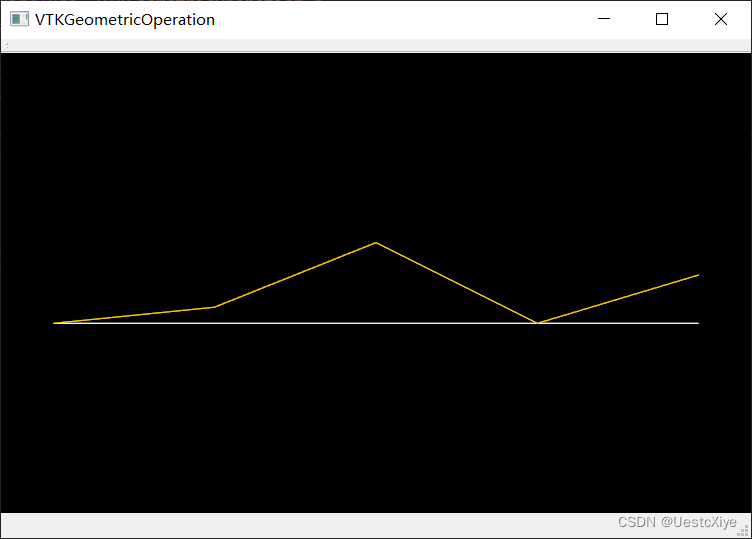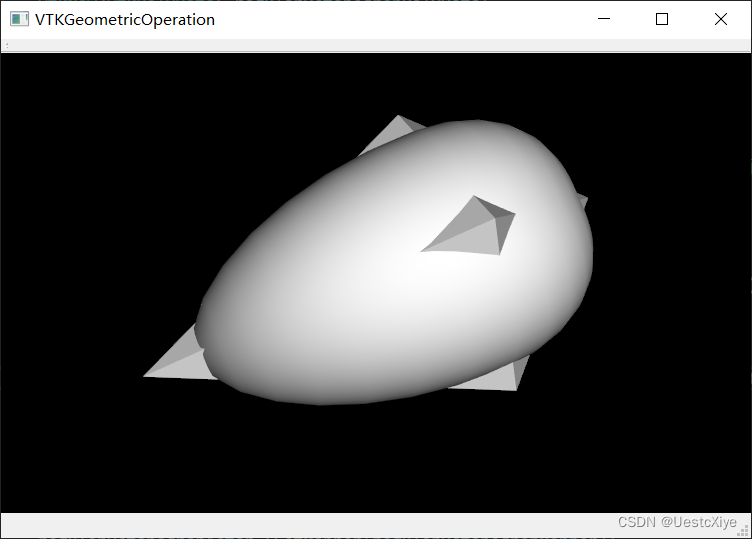VTK 数据处理:几何操作
VTK 数据处理:几何操作
VTK 的几何操作主要是让模型的点坐标发生偏移。
本文章主要介绍 3 种几何操作:
- 使用 vtkWarpTo 向指定点发生位移
- 使用 vtkWarpVector 按照指定向量发生位移
- 使用 vtkDeformPointSet 按照框架变形
实例 1:使用 vtkWarpTo 向指定点发生位移
vtkWarpTo 类可以设置点和比例,通过朝着该点弯曲来修改点坐标,用于将数据集中的点沿着指定向量进行位移。
#include "WarpTo.h"
#include <vtkLineSource.h>
#include <vtkWarpTo.h>
#include <vtkTubeFilter.h>
#include <vtkPolyDataMapper.h>
#include <vtkActor.h>
#include <vtkRenderer.h>
#include <vtkRenderWindow.h>
WarpTo::WarpTo(QWidget* parent) : QMainWindow(parent)
{
ui.setupUi(this);
_pVTKWidget = new QVTKOpenGLNativeWidget();
this->setCentralWidget(_pVTKWidget);
vtkNew<vtkRenderer> renderer;
this->_pVTKWidget->renderWindow()->AddRenderer(renderer);
this->_pVTKWidget->renderWindow()->Render();
vtkNew<vtkLineSource> line;
line->SetPoint1(0, 0, 0);
line->SetPoint2(0, 1, 0);
line->SetResolution(20);
line->Update();
vtkNew<vtkTubeFilter> tubeFilter;
tubeFilter->SetInputConnection(line->GetOutputPort());
tubeFilter->SetRadius(0.01);
tubeFilter->SetNumberOfSides(50);
tubeFilter->Update();
vtkNew<vtkWarpTo> warpTo;
warpTo->SetInputConnection(tubeFilter->GetOutputPort());
warpTo->SetPosition(10, 1, 0);
warpTo->SetScaleFactor(2.0);
warpTo->AbsoluteOn();
vtkNew<vtkPolyDataMapper> tubeMapper;
tubeMapper->SetInputConnection(tubeFilter->GetOutputPort());
vtkNew<vtkPolyDataMapper> warpToMapper;
warpToMapper->SetInputConnection(warpTo->GetOutputPort());
vtkNew<vtkActor> tubeActor;
tubeActor->SetMapper(tubeMapper);
vtkNew<vtkActor> warpToActor;
warpToActor->SetMapper(warpToMapper);
renderer->AddActor(tubeActor);
renderer->AddActor(warpToActor);
}
WarpTo::~WarpTo()
{
}
本实例中,我们创建了一个 vtkLineSource 类对象 line,设置它的起点和终点分别为 (0, 0, 0) 和 (0, 1, 0),并通过 vtkTubeFilter 将 line 变成一个圆柱。
创建一个 vtkWarpTo 类对象,设置点为 (10, 1, 0),偏转系数为 2。当AbsoluteOn设置为true时,位移是相对于数据集的原点进行的,这意味着所有的点都会向同一个方向偏移,即使它们在不同的位置上。但是,如果AbsoluteOn设置为false,则每个点的位移是相对于该点当前的位置进行计算的,这可能会导致每个点偏移到不同的方向,因此可能会产生非常不同的结果。
运行结果:

实例 2:使用 vtkWarpVector 按照指定向量发生位移
vtkWarpVector是VTK中的一个滤波器,用于根据向量数据对点进行位移。它将每个点的位置根据与该点相关联的向量进行调整,从而实现对数据集的形变操作。
该滤波器的作用是根据向量数据对点进行位移,可以用于创建各种效果,如流线、箭头、扭曲等。它可以用来可视化矢量场、流体运动、变形等应用场景。
使用vtkWarpVector滤波器时,需要提供一个向量数据集作为输入,这些向量表示了每个点的位移方向和大小。滤波器根据向量数据对每个点进行位移,从而改变其位置。位移的大小由向量的长度决定,位移的方向由向量的方向决定。
通过调整输入的向量数据,可以控制位移的强度和方向,从而实现各种不同的形变效果。这使得vtkWarpVector成为在可视化中展示矢量场和流体模拟等方面非常有用的工具。
#include "WarpVector.h"
#include <vtkPoints.h>
#include <vtkNamedColors.h>
#include <vtkProperty.h>
#include <vtkCellArray.h>
#include <vtkLine.h>
#include <vtkDoubleArray.h>
#include <vtkPointData.h>
#include <vtkWarpVector.h>
#include <vtkPolyData.h>
#include <vtkPolyDataMapper.h>
#include <vtkActor.h>
#include <vtkRenderer.h>
#include <vtkRenderWindow.h>
WarpVector::WarpVector(QWidget* parent)
{
ui.setupUi(this);
_pVTKWidget = new QVTKOpenGLNativeWidget();
this->setCentralWidget(_pVTKWidget);
vtkNew<vtkRenderer> renderer;
this->_pVTKWidget->renderWindow()->AddRenderer(renderer);
this->_pVTKWidget->renderWindow()->Render();
vtkNew<vtkNamedColors> colors;
vtkNew<vtkPoints> points;
points->InsertNextPoint(0, 0, 0);
points->InsertNextPoint(1, 0, 0);
points->InsertNextPoint(2, 0, 0);
points->InsertNextPoint(3, 0, 0);
points->InsertNextPoint(4, 0, 0);
vtkNew<vtkCellArray> lines;
vtkNew<vtkLine> line;
line->GetPointIds()->SetId(0, 0);
line->GetPointIds()->SetId(1, 1);
lines->InsertNextCell(line);
line->GetPointIds()->SetId(0, 1);
line->GetPointIds()->SetId(1, 2);
lines->InsertNextCell(line);
line->GetPointIds()->SetId(0, 2);
line->GetPointIds()->SetId(1, 3);
lines->InsertNextCell(line);
line->GetPointIds()->SetId(0, 3);
line->GetPointIds()->SetId(1, 4);
lines->InsertNextCell(line);
vtkNew<vtkPolyData> linePolyData;
linePolyData->SetPoints(points);
linePolyData->SetLines(lines);
vtkNew<vtkDoubleArray> warpData;
warpData->SetNumberOfComponents(3);
warpData->SetName("warpData");
double warp[] = { 0, 0, 0 };
warp[1] = 0.0;
warpData->InsertNextTuple(warp);
warp[1] = 0.1;
warpData->InsertNextTuple(warp);
warp[1] = 0.5;
warpData->InsertNextTuple(warp);
warp[1] = 0.0;
warpData->InsertNextTuple(warp);
warp[1] = 0.3;
warpData->InsertNextTuple(warp);
linePolyData->GetPointData()->AddArray(warpData);
linePolyData->GetPointData()->SetActiveVectors(warpData->GetName());
vtkNew<vtkWarpVector> warpVector;
warpVector->SetInputData(linePolyData);
vtkNew<vtkPolyDataMapper> lineMapper;
lineMapper->SetInputData(linePolyData);
vtkNew<vtkPolyDataMapper> warpMapper;
warpMapper->SetInputConnection(warpVector->GetOutputPort());
vtkNew<vtkActor> lineActor;
lineActor->SetMapper(lineMapper);
vtkNew<vtkActor> warpActor;
warpActor->SetMapper(warpMapper);
warpActor->GetProperty()->SetColor(colors->GetColor3d("Gold").GetData());
renderer->AddActor(lineActor);
renderer->AddActor(warpActor);
}
WarpVector::~WarpVector()
{
}
本实例首先创建了一个 vtkPoints 类对象 points,里面存储了 5 个点:(0, 0, 0)、(1, 0, 0)、(2, 0, 0)、(3, 0, 0)、(4, 0, 0)、(5, 0, 0)。接着创建了一个 vtkCellArray 类 line,里面存储了 前面 5 个点相邻两两连接的 4 条线段。最后用一个 linePolyData 类对象保存了 points 和 line。
创建一个 vtkDoubleArray 类对象 warpData,里面存储了 5 个向量数据:(0, 0, 0)、(0, 0.1, 0)、(0, 0.5, 0)、(0, 0, 0)、(0, 0.3, 0)。将这个数组添加到 linePolyData 中,并设为 ActiveVectors,之后使用 vtkWarpVector 类根据向量数据(刚刚设置的 warpData)对点进行位移。它将每个点的位置根据与该点相关联的向量进行调整,从而实现对数据集的形变操作。
运行结果:

实例 3:使用 vtkDeformPointSet 按照框架变形
vtkDeformPointSet 的主要作用是根据一组控制点和它们的位移,对输入的点集进行形变。该类通常用于实现基于物理模型或者仿真的点集形变,比如在有限元分析中用于模拟材料的变形行为。
使用vtkDeformPointSet,可以通过指定一组控制点和它们的位移来对输入的点集进行形变。控制点的位移可以通过外部计算得到,比如基于物理模型的仿真结果或者其他形变算法的计算结果。vtkDeformPointSet会根据这些位移信息,对输入的点集进行相应的形变操作,并输出形变后的点集。
这种形变操作可以用于模拟材料的变形、动态网格变形、动画效果等各种应用场景。通过调整控制点的位移,可以实现不同形式的形变效果,从而满足各种可视化和仿真需求。
#include "DeformPointSet.h"
#include <vtkSphereSource.h>
#include <vtkPoints.h>
#include <vtkCellArray.h>
#include <vtkDeformPointSet.h>
#include <vtkPolyDataMapper.h>
#include <vtkActor.h>
#include <vtkRenderer.h>
#include <vtkRenderWindow.h>
DeformPointSet::DeformPointSet(QWidget* parent) : QMainWindow(parent)
{
ui.setupUi(this);
_pVTKWidget = new QVTKOpenGLNativeWidget();
this->setCentralWidget(_pVTKWidget);
vtkNew<vtkRenderer> renderer;
this->_pVTKWidget->renderWindow()->AddRenderer(renderer);
this->_pVTKWidget->renderWindow()->Render();
vtkNew<vtkSphereSource> sphere;
sphere->SetThetaResolution(51);
sphere->SetPhiResolution(17);
sphere->Update();
double bounds[6];
sphere->GetOutput()->GetBounds(bounds);
// 正八面体
vtkNew<vtkPoints> points;
points->SetNumberOfPoints(6);
points->SetPoint(0, bounds[0] - 0.1 * (bounds[1] - bounds[0]), (bounds[2] + bounds[3]) / 2.0, (bounds[4] + bounds[5]) / 2.0);
points->SetPoint(1, bounds[1] + 0.1 * (bounds[1] - bounds[0]), (bounds[2] + bounds[3]) / 2.0, (bounds[4] + bounds[5]) / 2.0);
points->SetPoint(2, (bounds[1] + bounds[0]) / 2.0, bounds[2] - 0.1 * (bounds[3] - bounds[2]), (bounds[4] + bounds[5]) / 2.0);
points->SetPoint(3, (bounds[1] + bounds[0]) / 2.0, bounds[3] + 0.1 * (bounds[3] - bounds[2]), (bounds[4] + bounds[5]) / 2.0);
points->SetPoint(4, (bounds[1] + bounds[0]) / 2.0, (bounds[2] + bounds[3]) / 2.0, bounds[4] - 0.1 * (bounds[5] - bounds[4]));
points->SetPoint(5, (bounds[1] + bounds[0]) / 2.0, (bounds[2] + bounds[3]) / 2.0, bounds[5] + 0.1 * (bounds[5] - bounds[4]));
vtkNew<vtkCellArray> tris;
tris->InsertNextCell(3);
tris->InsertCellPoint(2); tris->InsertCellPoint(0); tris->InsertCellPoint(4);
tris->InsertNextCell(3);
tris->InsertCellPoint(1); tris->InsertCellPoint(2); tris->InsertCellPoint(4);
tris->InsertNextCell(3);
tris->InsertCellPoint(3); tris->InsertCellPoint(1); tris->InsertCellPoint(4);
tris->InsertNextCell(3);
tris->InsertCellPoint(0); tris->InsertCellPoint(3); tris->InsertCellPoint(4);
tris->InsertNextCell(3);
tris->InsertCellPoint(0); tris->InsertCellPoint(2); tris->InsertCellPoint(5);
tris->InsertNextCell(3);
tris->InsertCellPoint(2); tris->InsertCellPoint(1); tris->InsertCellPoint(5);
tris->InsertNextCell(3);
tris->InsertCellPoint(1); tris->InsertCellPoint(3); tris->InsertCellPoint(5);
tris->InsertNextCell(3);
tris->InsertCellPoint(3); tris->InsertCellPoint(0); tris->InsertCellPoint(5);
vtkNew<vtkPolyData> regularOctahedronPolyData;
regularOctahedronPolyData->SetPoints(points);
regularOctahedronPolyData->SetPolys(tris);
// vtkDeformPointSet 根据一组控制点和它们的位移,对输入的点集进行形变
vtkNew<vtkDeformPointSet> deformPointSet;
deformPointSet->SetInputConnection(sphere->GetOutputPort());
deformPointSet->SetControlMeshData(regularOctahedronPolyData); // 把正八面体作为控制网格
deformPointSet->Update();
double controlPoint[3];
points->GetPoint(5, controlPoint);
points->SetPoint(5, controlPoint[0], controlPoint[1], bounds[5] + 0.8 * (bounds[5] - bounds[4]));
points->Modified();
vtkNew<vtkPolyDataMapper> deformedSphereMapper;
deformedSphereMapper->SetInputConnection(deformPointSet->GetOutputPort());
vtkNew<vtkPolyDataMapper> regularOctahedronMapper;
regularOctahedronMapper->SetInputData(regularOctahedronPolyData);
vtkNew<vtkActor> deformedSphereActor;
deformedSphereActor->SetMapper(deformedSphereMapper);
vtkNew<vtkActor> regularOctahedronActor;
regularOctahedronActor->SetMapper(regularOctahedronMapper);
renderer->AddActor(deformedSphereActor);
renderer->AddActor(regularOctahedronActor);
}
DeformPointSet::~DeformPointSet()
{
}
本实例创建了一个球体和一个正八面体。通过创建一个 vtkDeformPointSet 类,把球体作为输入,把正八面体作为控制网格。程序修改了正八面体的一个点的坐标,vtkDeformPointSet 类根据一组控制点(正八面体的点集)和它们的位移,对输入的点集(球体)进行形变。
运行结果:























 1112
1112

 被折叠的 条评论
为什么被折叠?
被折叠的 条评论
为什么被折叠?










